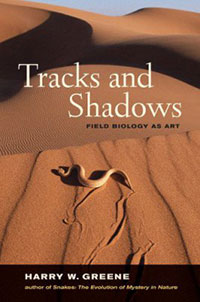The Greene world: Book depicts field biology as art
By Linda B. Glaser

More than 40 years of fieldwork on six continents has made Harry Greene one of the world’s leading snake experts. His new book, “Tracks and Shadows: Field Biology as Art,” is an autobiographical celebration of his experiences as well as what Greene calls “an eccentric meditation on natural history.”
The book is woven around two central themes: coming to terms with the destruction of habitat and the loss of biodiversity, and the “twists and turns of my personal quest for wildness,” writes Greene, professor of ecology and evolutionary biology and a Stephen H. Weiss Presidential Fellow. He explores how nature eases our existential quandaries and how natural historians transform curiosity into science and help save species from extinction.
Greene also discusses the nuts and bolts of field research and teaching, imparts the basics of snake biology, and introduces explorers Charles Darwin and Alfred Russel Wallace. Along the way, he immerses the reader in the “sheer poetry” of field biology, demonstrating that “natural history offers an enlightened form of contentment.”

The book is shaped by what Greene calls his “peculiar life,” beginning with his childhood curiosity about the natural world. “I was a real snake nerd,” he says. “When I got to college I’d already published three papers but I’d never gone out with girls.”
Before becoming a professor, he spent years working as a mortician's assistant, ambulance driver and army medic. He draws a connection between the violence he experienced in these professions – armed attackers, dying children and the murders of people he loved – to his fascination with dangerous animals and the predator-prey relationship.
“Basically I’m trying to find out the truths of nature and myself, asking questions about life and death and why it matters,” he explains. “I’m doing what an artist does: perceiving reality, translating it into some expression, and thereby discovering value for myself and also for others.”
Greene is passionate about the need to make biological diversity and conservation interesting to nonspecialists. Believing that people care more, pay more and will sacrifice for things that they understand, he is committed to promoting biological diversity, ecology, behavior and conservation as among the core components of scientific literacy. As an additional benefit, he writes, “The practice of natural history fosters peace of mind.”
In the penultimate chapter, Greene takes up arms to feed his family as a “born-again predator.” “After 35 years of studying predators, I became one,” he says. “The last chapter is about owning up to that. The first time I killed a deer my first thoughts were: sacred, intimate, grateful.”
As in his previous book, “Snakes: The Evolution of Mystery in Nature” (which won the 1998 PEN Center USA West Literary Award), Green also tackles questions of anthropomorphism and wilderness.
“I would like to get people to think more deeply about what ‘pristine’ means,” he says, “the notion that ‘let nature take its course’ and all will be fine.”
Linda B. Glaser is staff writer for the College of Arts and Sciences.
Media Contact
Get Cornell news delivered right to your inbox.
Subscribe